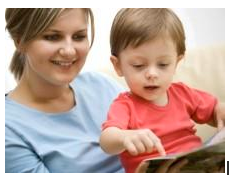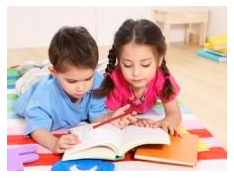Children Enjoy Reading
Literacy doesn’t start only when your child starts school. From birth, babies and children are gathering skills they’ll use in reading. The years between ages 0 and 5 are critical to reading growth, and some 5-year-olds are already in kindergarten.
The best way to instill a love for and interest in reading is to simply read to your child and yet, many parents don’t. Reading gives you the opportunity for close bonding with your child, and it also provides a window into a world of literacy that your child is about to enter.
As your child goes from saying her first sentences to speaking in paragraphs, you will start to see exciting milestones develop with reading. Your child will begin to recognize print on the street, stop signs, familiar store signs, and the address posted on your home.
Talk About Text
A text-rich environment for preschoolers lays the groundwork for reading success. It’s not just about having books in the home, although that’s a great start. You can also start talking about letters, numbers, and words on packages and signs.
Help your child see how text is already a part of his daily life. Point out the name of his favorite cereal. Show him the labels on clothing. Show him the different parts of a birthday card or invitation.
When you are out and about, play games involving letter and number recognition. Can your child tell you any of the letters in the supermarket sign? Can she read the serving amount on a packaged snack? She will be delighted to understand more about her world — but don’t push her delight. Developing text awareness should never be a chore.
Be Aware of Problems
Are you concerned that your child might have a learning disability? As with almost any disability, early intervention can prevent problems in the future. In the preschool years, speech delays are much more noticeable than the learning disabilities that may affect a child’s efforts to read. Ask your pediatrician for advice if you are concerned that your child is speech delayed.
Most school districts will not diagnose reading disabilities until first grade. However, there are signs that you can look for earlier. If your 5-year-old can’t “hear” the rhyme in two simple words, or cannot differentiate between a letter and a random squiggle, this may be an area of development you’ll want to keep an eye on.
Reading Activities for Ages 0-2

Use Your Voice
Animal noises. Tongue-clicking. Raspberries. Songs! No one loves funny sound effects more than your baby does. Don’t be afraid to go over the top with weird noises as you read. Your baby will start to imitate you, and your first “conversation” may ensue.
Visit the Library
Once your child can hold books on her own, bring her to your nearest library. Offer her a selection of books and see which ones she picks up, and which ones she pays attention to for the longest time. You can check out her favorites (at this age, stick with board books) and enjoy them together at home.
Be a Role Model
Your baby is playing on his own. You’re eyeing that magazine you had to put down when he got up from his nap. Your baby is happily amusing himself with a toy. Feeling too guilty to read while your baby is awake? Grab that magazine and relax! One of the top tips for building literacy in kids is to be a role model and show him how you love to read too. You may be surprised to find your baby leafing through a pile of books by himself as well.
Familiar Faces
Find a plastic-coated baby’s photo album that you can put pictures into. Your baby will love leafing through pictures of her loved ones. Be sure to include lots of pictures of your baby, too. As you “read” the photo album, tell her stories of the fun things she has done with the person she’s looking at. Pretty soon, she will be able to leaf through the book and identify every picture.
Look it Up
You are driving in the car and pass a construction site. As a jackhammer rips through the pavement, a backhoe lifts dirt from a pit. From the car seat in the back, you can hear you son go wild. This is a kid who needs a book about construction vehicles! Whether your little one demonstrates an interest in dogs, flowers, or balls, there will be a book with pictures that will fascinate him.
Reading Activities for Ages 3-5

Fun with Letters
Children enjoy copying words out onto paper. Write your child’s name and have him copy it himself with alphabet stamps, stickers, or magnets. Encourage him to “write” his own words using the letters. Your child will write letters backward, spell seemingly randomly, and may hold his marker strangely — it’s “all good” at this age when a child wants to communicate in writing of any kind.
What Word Starts With…
The letter-sound connection is one of the first steps to reading. Play a guessing game about your child’s favorite words. What letter does “p-p-p-pirate” start with? How about “M-m-mommy”? Once your child guesses one correctly, see how many words you can come up with together that start with the same letter.
Your Child the Author
Three-year-old’s can be chatty, and by age 4, it can be hard to get a word in edgewise. Take advantage of your child’s interest in talking by writing a book together. Start out with something simple, like describing a fun day at a park or visiting friends. Staple a few pieces of paper together, and write out one or two of your child’s sentences on each page. Then, read the story to her and let her illustrate it.
A Different Way to Read
Reading to your child is great — but what’s even better is something called “dialogic” reading. That’s when you ask your child to participate in the story. Before turning the page, ask your child what he thinks will happen next. You can also ask your child what another way the book could have ended. For example, with the classic book Corduroy, what would have happened if the little girl hadn’t come back to take Corduroy home from the toy store?
Take Letters Outside
Kids are tactile and enjoy few activities more than poking things with a stick. Many preschools encourage kids to make letters out of Play Doh or draw them into sand or clay. The next time you are out in the park, or at the beach, or in the snow, use your surroundings to play with letters. Take turns writing letters in the snow, dirt, or sand.
Just the Facts
Try getting your child interested in nonfiction books. At the library or bookstore, find books on your child’s favorite topics. Cars, dinosaurs, dogs, and other topics are covered in on-level books with plenty of pictures, designed especially for kids this age.





